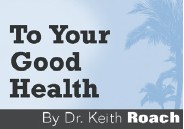DEAR DR. ROACH: It seems that eating a healthy diet with an emphasis on nuts and seeds, fruits, vegetables and grains is the best choice for anyone. It’s been well-documented that Omega-6 is inflammatory, whereas foods containing Omega-3 are not.
It seems to me that we should be consuming foods that have more Omega-3 in them. The only problem is that, from my research, all nuts and seeds, with the exception of chia and flaxseeds, have a much higher ratio of the Omega 6 to the Omega-3.
This appears to be the case with most foods, no matter which food group they are in. How can any of the healthy foods be beneficial when so much more of the “bad fats” is being ingested? – Anon.
ANSWER: Dietary fats are categorized into four groups: monounsaturated, polyunsaturated, saturated and trans-saturated. It is accepted that monounsaturated fats have a healthy effect, reducing heart disease risk, while trans saturated fats are clearly harmful. The effect of saturated fats on health is mixed, but those that come from processed meat increase heart disease and diabetes risk. Saturated fat, overall, has little effect on heart disease risk, but swapping saturated fat with unsaturated fats (both polyunsaturated and monounsaturated) appears to reduce heart disease risk.
Polyunsaturated fats are categorized into the Omega- 3 family and the Omega-6 family. I also have read in many places that Omega-6 fats are “bad fats,” causing inflammation. The best evidence, a 2014 review of all controlled trials published, showed that Omega-6 fats are not inflammatory and that they decrease risk of heart disease, compared with meat based saturated fats.
We should be consuming both Omega-3 and Omega-6 polyunsaturated fats, mostly from plant sources. The data support that nuts and seeds are foods we should be eating more of, but we also should be eating good sources of Omega- 3, including fatty fish, the chia and flaxseeds you mentioned, as well as walnuts and canola oil. Most people have to work harder to get Omega-3 oils but get plenty of Omega-6.
***
DEAR DR. ROACH: I have recently started transitioning to a plant-based diet for preventative health reasons. While discussing the benefits of nuts and seeds with a dietitian, I found they had a disclaimer that flax-seed can interfere with medications and to eat them two hours before or one hour after taking medications. I would not sit down and eat a handful of flax seeds, but now I am afraid to use them in the meals I prepare at all. Can you help me make a good decision in using them? – J.E.
ANSWER: For people eating reasonable amounts (like a handful or two) of flax seeds as part of a meal, it is unlikely that they would interfere with medications enough to cause any significant problem, for most medications.
There are two situations that might merit concern: In powerful anti-clotting agents, such as clopidogrel, flax seeds might prompt increased activity. Secondly, flax seeds may lower blood sugar a small amount.
In combination with insulin or oral diabetes drugs, the blood sugar could possibly dip lower than expected. I doubt either of these interactions is likely to cause harm, but it is reasonable to discuss with your doctor if you are on one of the classes of medications mentioned.
***
Dr. Roach regrets that he is unable to answer individual questions, but will incorporate them in the column whenever possible. Readers may email questions to ToYourGoodHealth@ med. cornell.edu.



